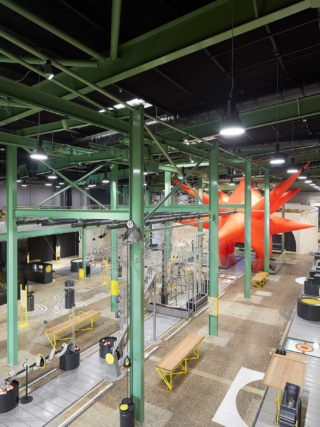De Matos Ryan’s design for Wonderlab: The Bramall Gallery at the National Railway Museum adopts the design language associated with locomotion and aims to inspire the next generation of engineers.
Wonderlab: The Bramall Gallery at the National Railway Museum has opened its doors to the train-loving public. Won through a competition, architect de Matos Ryan’s design for the 1,500-square-metre space sees 18 interactive exhibits and installations highlight a myriad of engineering concepts associated with train travel.
The Wonderlab is housed in a former locomotive repair workshop, for which the industrial feel has been maintained to amplify the fact that this is a place for engineering. With this in mind, de Matos Ryan have used the spacious warehouse to define it as an engineering playground. There is no prescribed circulation through the space and visitors (the target audience is seven to 14-year-olds and above) are free to carve their own path to each of the exhibits at their own pace.
Areas for a particular focus have been delicately delineated through new timber structures that screen and layer areas to create more intimate spaces that break away from the open plan of the wider scheme. These additions, too, link to the railway by embodying locomotive motifs while also adopting the scale of railway engineering necessities, such as being reminiscent to train turntables as well as engine components.
The Wallace Learning Space, for example, is a nod in form to the tubing and flues found within a typical steam engine’s boiler. Large cardboard tubes have been placed in the ceiling of the almost cylindrical pavilion from which they extrude beyond. For architectural purposes (and certainly not water boiling purposes) these tubes have been lined with acoustic insulation in order mitigate sound from the main gallery hall. Externally, the Douglas Fir envelope is defined by a simple pattern that is evokes mechanical gearing systems.
Another example of this design language can be seen with the Weston Show Space (pictured above) which takes cues from a locomotive driving wheel for its form, being used as a seated auditorium for presentations and demonstrations to describe in more detail various engineering phenomena associated with locomotion, aided by a large AV screen and demonstration desk.
The design for the ‘Flow Lab’, meanwhile, has been inspired by railway signalling control centres, with a large interactive digital interface occupying a curved timber screen. Within this circular space (as defined by markings on the ground) tables and free-standing benches take inspiration from smaller scale, as-found fragments, such as scaffold structures, trusses and locomotive skeletons, reminiscent of those originally found within the old railway repair workshop.
Green steel beams visually dominate the hall alongside Mass – a large scale permanent artwork by Steve Messam that sees a giant orange, spiky textile inflatable rise from the pit of a former wheel drop to the ceiling, dramatically filling the space between the two.
Poplar timber has been used line the perimeter of the hall, in turn adding a warmer and softer texture at ground level, serving as a contrast to the rough and industrial surfaces that define the space as a whole. The timber skirting also doubles up as workbenches, seating areas, storage cupboards and viewing portals at various points throughout the hall.
“It was important for the gallery to maintain the patina and texture of the existing workshop and its primary structures,” said the architects in statement. “Imperfections and historical wear and tear are exposed and celebrated. Where possible, the memory, rawness and energy of the building’s historic use has been maintained.”
“The well trafficked and functional concrete slab of the workshop floor had developed cracks and its own patina,” they added. “This robust and industrial finish has been brought back to life by stripping back modern layers of grey floor paint, carefully repairing, polishing and sealing it. Retaining the original slab’s patina, staining and grittiness has delivered a revived terrazzo-like gallery floor finish. New graphic markings, reminiscent of the old workshop’s signs, define activity areas and thematically correlate to interactives and building structures. Larger-scale original workshop constructions, such as the wheel drop, pits and cranes, have been repurposed to provide the infrastructure that supports the new content. Railway tracks are exposed, while glazed views into the railway track pits have been maintained. New interventions have been carefully stitched into the existing historic building fabric.”






























